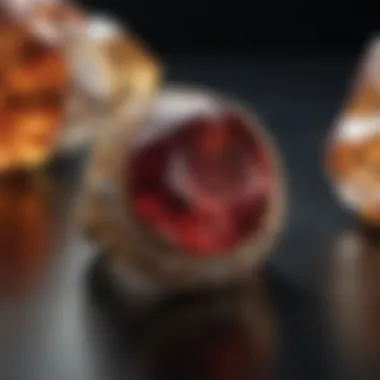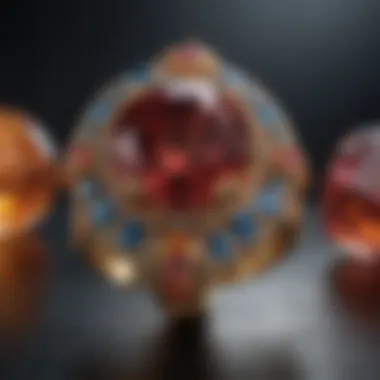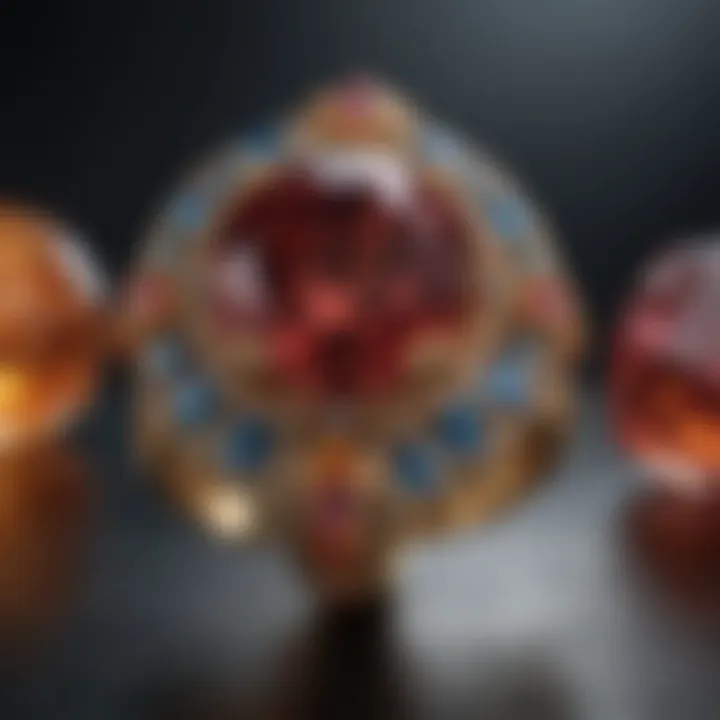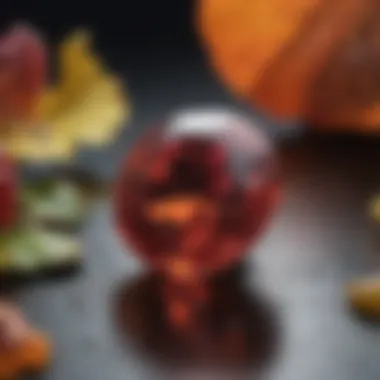The Birthstone of October 26th: A Comprehensive Exploration


Intro
The birthstone associated with October 26th carries a wealth of significance, both in terms of its beauty and its intrinsic qualities. This article aims to provide a thorough exploration of this gemstone, detailing not only its geological background but also its historical relevance and symbolism. By examining the various facets of the birthstone, this narrative serves as a resource for gemstone enthusiasts, collectors, and those interested in jewelry design.
Gemstone Overview
Definition and characteristics
The birthstone for October 26th is the opal. Opals are unique, possessing a distinctive play of color that sets them apart from other gemstones. Unlike many gemstones, opals do not have a crystalline structure. Instead, they are formed from silica gel that solidifies over time, incorporating water molecules and creating a structure that diffracts light. This results in the magnificent display of colors, known as opalescence, which can encompass a range of hues, from blues and greens to fiery reds and oranges.
Classification of gemstones
Gemstones are classified based on several criteria, including their composition, hardness, and optical properties. Opals are categorized under the mineraloid class, as they lack a specific crystal structure. Within the opal group, there are several varieties, including precious opal, which displays a vibrant play of color, and common opal, which lacks this feature. Additionally, there are unique forms, such as fire opal, known for its warm, translucent orange and yellow shades.
Properties of Gemstones
Physical properties
Opals possess several physical properties that make them distinct. Their hardness ranges from 5.5 to 6.5 on the Mohs scale, making them relatively soft compared to other gemstones. This characteristic requires careful handling to prevent scratches and damage. Furthermore, opals can display a changing appearance when viewed from different angles, a trait attributed to their internal structure that refracts light at various wavelengths.
Chemical properties
The primary chemical composition of opal is hydrated silicon dioxide, which is significant in determining its properties. The presence of water, typically 3% to 21% by weight, contributes to their unique characteristics and affects their durability. When opals dry out, they can become brittle, leading to cracks and other forms of damage. Thus, understanding their chemical makeup is crucial, especially for those interested in jewelry design or collection.
"Opals are not just beautiful; their fascinating properties make them a subject of study for both gemologists and enthusiasts alike."
Understanding Birthstones
Birthstones have long been regarded as more than mere decorative pieces. Their significance extends into culture, history, and even belief systems. This article aims to illuminate the multifaceted nature of birthstones, focusing particularly on the one associated with October 26th. Understanding birthstones involves recognizing their roles in personal identity, emotional connections, and spiritual meanings.
Definition and Origin
The term "birthstone" refers to gemstones that are traditionally associated with each month of the year. The origins of this practice are ancient, tracing back to biblical times when the Breastplate of Aaron was documented in the Book of Exodus. This breastplate contained twelve stones, each representing a different tribe of Israel. As time progressed, these stones were linked to the twelve zodiac signs and later to the months of the year.
While the modern associations may differ from their ancient counterparts, the underlying belief remains: wearing one’s birthstone is thought to bring good fortune, health, and protection. The Opal, for October, encompasses these attributes along with various layers of meaning.
Historical Significance
Throughout history, birthstones have symbolized not only personal identity but also cultural heritage. Ancient civilizations, such as the Babylonians and Egyptians, revered these gems for their beauty and supposed powers. For instance, in ancient Rome, it was common to wear the appropriate gem of one’s birth month to harness its therapeutic benefits or protective qualities.
In the 20th century, the American National Retail Jewelers Association standardized the list of birthstones, making it more accessible to the general public. This move linked birthstones closer with personal significance, driving consumer interest and further embedding them into social traditions.
Cultural Variations
Cultural interpretations of birthstones vary vastly across regions and traditions. In Western cultures, the significance of Opal for October is widely recognized, but other societies may have different stones associated with the same month.
For example, in Indian astrology, specific gems are believed to hold unique powers that can influence one's fate and personality. Birthstones from various cultures are often linked to specific planetary influences or personal attributes. This diversity showcases how gemstones transcend mere aesthetics, carrying rich narratives that differ across cultural contexts.
The Birthstone for October
The significance of October's birthstone lies in its rich characteristics and meanings that reflect both geological properties and cultural implications. This month offers not only one but two distinct gemstones: Opal and Tourmaline. Understanding their features can enhance appreciation for their beauty and rarity. For enthusiasts, knowing the specifics about these birthstones allows for informed choices in jewelry design, collection practices, and even personal symbolism.
Identifying October's Birthstones


To identify the birthstones of October effectively, one must recognize the distinctions between the primary and alternative stones. Opal, recognized for its vibrant play-of-color, captures attention immediately. Its unique ability to display multiple colors in a single stone differentiates it from more traditional gemstones. Conversely, Tourmaline offers a more varied palette, with different types presenting hues that range from pink to green, and even bi-color samples like watermelon tourmaline.
Primary Birthstone: Opal
Opal is celebrated as the primary birthstone for October. This gemstone is not merely admired for its aesthetics, but also for its geological complexity. Opals typically form in sedimentary rocks and are composed of silica. The internal structure of the stone promotes a distinctive optical phenomenon known as "opalescence." This effect involves the reflection of light, creating a spectrum of colors as viewed from different angles. Notably, the most prized form is the precious opal, which shows vivid play-of-color. This particular quality is closely scrutinized in terms of quality and value.
Alternative Birthstone: Tourmaline
Tourmaline serves as the alternative birthstone for October. This gemstone presents remarkable variety and color diversity. The hexagonal crystal system of Tourmaline contributes to its ability to display different colors due to its complex chemical structure, which includes elements like lithium, iron, and magnesium. Among its various forms, the striking rubellite and the popular elbaite are well-known. Watermelon tourmaline, a unique bi-colored variety, showcases both pink and green hues within the same crystal. This appealing feature makes Tourmaline not only valuable but also a favorite among collectors and jewelry designers alike.
Opal: The Birthstone of October 26th
Opal holds a special significance as the birthstone for those born on October 26th. Its reputation as a gemstone of inspiration and creativity makes it particularly relevant for individuals born under this date. The fascinating interplay of colors within opals is said to mirror the dynamic personalities of those who wear them. This section will explore various aspects of opal, focusing on its geological characteristics, different types, and formation processes.
Geological Characteristics
Opal is a mineraloid, primarily made of hydrated silica. Its unique composition means it does not have a crystalline structure like traditional gemstones. Instead, opals contain small spheres of silica that create a play-of-color, a characteristic that sets them apart.
Opals form in a variety of environments, often occurring in sedimentary rocks. They require specific conditions to develop their intricate internal structures. These geological factors, combined with the right amount of water, lead to the creation of opal deposits, making the study of opal essential for gemologists and enthusiasts alike.
Types of Opal
Different types of opal present varied characteristics, each with unique traits that appeal to collectors and jewelry makers. In this article, we will discuss three main types of opal: precious opal, common opal, and fire opal.
Precious Opal
Precious opal is known for its vibrant and captivating colors. Its primary contribution to the topic lies in its ability to refract light and produce dazzling displays. This opal type often features a rich play-of-color, making it a sought-after choice for high-end jewelry. The most valued characteristic of precious opal is its opalescence.
The unique feature of precious opal is its internal structure that allows light to diffract. This can turn a simple piece of jewelry into a spectacle of colors, captivating anyone who lays their eyes on it. However, precious opal is also more delicate compared to some other gems, requiring careful handling to avoid damage.
Common Opal
Common opal, unlike its precious counterpart, does not showcase the same vibrant color play. Its contribution to the overall discussion is significant, particularly for those who appreciate the more subtle beauty of stones. The key characteristic of common opal is its uniform color, which can range from white to brown and even black.
One advantage of common opal is its affordability. This makes it a popular choice for casual jewelry and decorative items. While it may lack the visual impact of precious opal, common opal's charm lies in its simplicity and versatility in design.
Fire Opal
Fire opal is another fascinating variety, known for its warm, fiery hue, often in shades of orange, red, or yellow. One specific aspect of fire opal is its transparency and the occasional presence of sparkling inclusions. This type of opal often lacks the play-of-color characteristic of precious opal, yet its vibrant colors make it an appealing option for unique jewelry pieces.
The key characteristic of fire opal is its brilliant coloration, which sets it apart from other types. Its unique fiery appearance can evoke strong emotional responses, making it a beneficial choice in expressing individuality. However, fire opal may require more careful sourcing to ensure that the colors are genuine and not artificially enhanced.
Formation Process
The formation of opal is an intricate process influenced by environmental factors. The primary factor involved is the presence of silica-rich water, which seeps into rock crevices and eventually solidifies, forming sedentary layers of opal. Over millions of years, these processes lead to the creation of opal deposits.
The gradual evaporation of water allows the silica to settle and bond with other minerals. Thus, opal can be found in a variety of forms and locations around the world. Understanding this formation process helps enthusiasts appreciate the natural beauty and complexity inherent in each stone.
Tourmaline: The Alternative Birthstone
Tourmaline serves as the alternative birthstone for October. Its significance resonates in various ways. This gemstone is not only aesthetically pleasing but also rich in history and culture. Tourmaline is known for its wide range of colors and types, making it a versatile choice for different kinds of jewelry. When discussing the birthstone for October, Tourmaline can't be overlooked.
Geological Characteristics
Tourmaline is a complex boron silicate mineral. Its composition can include aluminum, iron, magnesium, sodium, lithium, and other trace elements. This variability in composition gives rise to various colors and forms. Tourmaline crystals often display a unique prism shape and can be found worldwide. Notable sources include Brazil, the United States, and Madagascar, among others. The crystals are typically found in igneous and metamorphic rocks and sometimes in alluvial deposits where they have been weathered away from the primary source. The hardness of Tourmaline on the Mohs scale ranges from 7 to 7.5, making it suitable for various jewelry applications.


Varieties of Tourmaline
Tourmaline comes in many varieties, each with distinct characteristics and charm. The most significant types include Elbaite, Rubellite, and Watermelon.
Elbaite
Elbaite is a popular variety of Tourmaline known for its rich colors, which can range from green to blue, and even pink. It is well-regarded for its vibrant hues, making it a favored choice among collectors and jewelry designers. The unique feature of Elbaite is its ability to exhibit multiple colors within a single crystal, often referred to as "bicolor" or "tricolor." This characteristic adds to its appeal. One advantage of Elbaite is its extensive history in the gemstone market, which has led to a higher value. However, it can also be rarer than some other varieties.
Rubellite
Rubellite is recognized for its striking red to pink shades. This coloration can be quite intense, making it a favored choice for those interested in statement jewelry. The deep colors of Rubellite can capture attention and are often associated with passion and energy. Its value can be significant, depending on the size and clarity of the stone. A notable advantage of Rubellite is its broad availability and popularity in the market. However, some high-quality stones can be rather expensive, limiting access for some buyers.
Watermelon
Watermelon Tourmaline is distinguished by its unique appearance. Typically, it features a vivid pink center surrounded by a green exterior. This gemstone's color combination is visually striking and garners much admiration. Watermelon Tourmaline is often associated with emotional healing and balance. Its unique dual-color structure can sometimes point to larger pieces being cut into slices for jewelry application. Although sought after, high-quality Watermelon Tourmaline can be costly, making it a more luxurious option.
Formation Process
The formation of Tourmaline occurs through complex geological processes. It generally forms in granite and pegmatite deposits. During cooling, the elements necessary for Tourmaline's structure become concentrated, allowing crystals to grow. Over millions of years, natural conditions such as temperature and pressure changes contribute to the final appearance of Tourmaline crystals. This geological background contributes to the stone's unique properties, including its wide array of colors.
In summary, Tourmaline stands as an intriguing alternative birthstone for those born in October. Its geological characteristics, varieties like Elbaite, Rubellite, and Watermelon, along with its distinct formation process, not only enhance its charm but also ensure a captivating narrative for gemstone enthusiasts.
Cultural Significance of Opal and Tourmaline
Birthstones often carry profound cultural weight. Opal and tourmaline, the birthstones for October, are no exceptions. These gems are not just beautiful; they embody rich mythologies and significant symbolism that have evolved over centuries and across various societies. Understanding the cultural significance of these stones enhances one's appreciation for them, placing their aesthetic qualities within a broader context.
Mythological Associations
Opal has been linked with numerous mythologies throughout history. In ancient Rome, opal was considered a symbol of hope and purity. Romans believed that it was a protector of the heart. This notion held true especially in medieval times when opals were thought to bring good fortune. The ancient Greeks associated opals with foresight and prophetic wisdom. They believed that the stone had the power to give its owner the gift of prophecy.
On the other hand, tourmaline also carries a rich tapestry of mythological associations. In the 16th century, it was said that tourmaline could absorb energy and provide healing. Ancient cultures viewed tourmaline as a talisman, a stone that could protect against negativity or harm. Some Native American tribes particularly revered this stone, holding a belief that it could connect the wearer to spiritual energies.
Both stones embody stories that add a deeper narrative to their existence. These tales contribute to their allure and establish them as more than simple decorative objects.
Symbolism in Different Cultures
The symbolism tied to opal and tourmaline varies widely among cultures. In Hindu tradition, opal is seen as a protective stone. It is believed to promote emotional and spiritual healing. In contrast, in various Asian cultures, tourmaline is regarded as a stone that fosters peace and balance. Its multifaceted colors symbolize the complexity of life itself, which resonates with many people.
In contemporary jewelry design, these stones are often incorporated to convey specific meanings. For example, opal can symbolize commitment and loyalty in relationships, making it a popular choice for engagement rings. Tourmaline, with its vibrant colors, is frequently used in jewelry aimed at those seeking emotional balance and protection.
"Each stone has a unique story, reflecting the rich heritage of the cultures they belong to, while also enhancing personal and emotional connections for those who wear them."
Moreover, in various rituals and celebrations, both stones are used to symbolize renewal and new beginnings. They are often chosen for gifts at weddings and other significant life events, further embedding them into the cultural practices of communities around the world. Recognizing these elements within opal and tourmaline not only enriches the narrative for gemstone enthusiasts but also for collectors and jewelry designers who seek to embed meaning into their creations.
Metaphysical Properties
The realm of metaphysical properties encompasses the non-physical aspects of gemstones, providing insights into their energetic qualities. This section emphasizes the significance of understanding these properties as they relate to personal growth, healing, and protection. For many enthusiasts, the allure of opal and tourmaline lies not only in their visual beauty but also in the perceived benefits they offer. Knowing the metaphysical attributes can influence how these stones are utilized in daily life and personal practices.
Opal's Healing Properties
Opal is often celebrated for its multifaceted healing properties. It is believed to enhance emotional balance and stimulate creativity, making it particularly appealing to artists and free spirits. Individuals who use opal often report experiencing improved inspiration and clarity in their creative endeavors. Moreover, it is thought that opal can assist in healing emotional traumas, allowing individuals to release negative feelings and promote self-acceptance.
Some specific benefits attributed to opal include:
- Emotional Healing: Facilitating insight into unresolved issues to help heal emotional wounds.
- Enhanced Intuition: Encouraging deeper connection to one's inner voice and intuition.
- Physical Well-being: Some practitioners believe that opal can help in stabilizing metabolism and improving overall health.


Each type of opal may carry distinct attributes. For example, while white opal is associated with innocence and purity, black opal is seen as a stone of great protection and strength.
Tourmaline's Protective Qualities
Tourmaline stands out for its powerful protective qualities. It is often referred to as a grounding stone, known for creating a shield against negativity. Collectors and practitioners use tourmaline to establish a protective barrier around themselves, especially in environments that may be energetically overwhelming.
Some notable aspects of tourmaline's protective properties include:
- Electromagnetic Field Protection: It is believed to protect against harmful electromagnetic frequencies (EMFs) which can arise from electronic devices.
- Emotional Stability: This stone is often used to disperse negative energy and promote self-confidence, allowing individuals to navigate life’s challenges more effectively.
- Chakra Balancing: Different colors of tourmaline correspond to specific chakras. For instance, green tourmaline is connected to heart chakra healing, while black tourmaline is often linked to root chakra stability.
Tourmaline's unique crystalline structure enables it to absorb and dissipate negative energies, making it an essential stone for those seeking spiritual protection.
Understanding these metaphysical properties allows enthusiasts to engage with opal and tourmaline beyond their aesthetic appeal, utilizing their energies to enhance personal well-being and emotional health.
Practical Considerations for Collectors
When it comes to collecting gemstones, there are several factors to consider. Collectors often seek unique pieces that stand out, especially with October's birthstones, Opal and Tourmaline. The importance of understanding practical considerations cannot be overstated. They ensure that the choices made are well-informed, which enriches the collecting experience.
Selecting Quality Stones
Quality is a vital element in selecting gemstones. The characteristics of Opal and Tourmaline vary significantly, thus influencing their value. For Opals, clarity, color play, and origin are key factors. Buyers should look for stones with vivid color displays, as these are more desirable.
- Clarity: A high-quality Opal should have minimal inclusions. Check for the presence of clarity grade.
- Color Play: The spectrum of colors exhibited (known as "play-of-color") varies from stone to stone. Ideal stones show multiple colors in various lighting.
- Origin: The provenance of an Opal affects its value. Australian Opals are among the most sought after due to their superior quality.
In contrast, the grading of Tourmaline revolves around the following aspects:
- Color: Varieties like Rubellite or Paraiba can command higher prices.
- Clarity: Look for stones with fewer inclusions.
- Size: Larger stones are generally rarer and thus more valuable.
In summary, verify all these elements before purchasing. Doing so helps purchasers ensure they are investing in quality.
Ethical Sourcing
As awareness rises concerning environmental impact, ethical sourcing has emerged as a significant consideration for gemstone collectors. Sourcing stones responsibly means ensuring that the gemstones are mined in a manner that respects both human rights and the environment.
- Conflict-Free Assurance: Inquire if the gemstone comes from conflict-free zones. This guarantees that its extraction did not fund violence or human rights abuses.
- Sustainable Practices: Choose stones harvested from operations that prioritize ecological conservation. Mines that minimize their carbon footprint contribute positively to the environment.
- Transparent Supply Chains: Look for sellers who maintain transparency in their sourcing. This builds trust and provides assurance about the ethical background of the gemstones.
Ethical sourcing is critical for preserving the integrity of the gemstone market. It sets a standard for sustainability while enhancing the value of the stones collected.
Uses in Jewelry
The role of gemstones in jewelry is not merely decorative. They embody emotions, status, and cultural heritage. Opal and Tourmaline, the birthstones for October, offer unique qualities that make them particularly desirable in various jewelry forms. Their vibrant colors and distinct patterns cater to both traditional and contemporary designs, making them versatile additions to any collection.
Common Jewelry Settings
Jewelry designers often utilize different settings to showcase the beauty of Opal and Tourmaline. Popular settings include:
- Prong Settings: These keep the stone secure while allowing light to penetrate. This is essential for Opal, as its play-of-color is best viewed from multiple angles.
- Bezel Settings: Provides a sleek and modern look. Tourmaline can benefit from this type of setting as it emphasizes the stone's color saturation.
- Channel Settings: Often used for small stones, this method creates a continuous row, enhancing the overall aesthetics of bracelets or rings.
These settings not only emphasize the stones’ natural beauty but also protect them from damage, which is a critical consideration in jewelry design.
Care and Maintenance
Both gemstones require proper care to maintain their beauty. For Opal, avoiding harsh chemicals is crucial, as they can dull its surface. Regular cleaning with a soft cloth ensures the stone retains its vibrant play-of-color. On the other hand, Tourmaline is generally more durable but can still benefit from careful handling to prevent scratches. Using a mild soap solution for cleaning can help keep it radiant.
Tips for caring for Opal and Tourmaline jewelry:
- Store pieces separately to prevent scratches.
- Avoid exposure to extreme temperatures or harsh conditions.
- Remove jewelry before engaging in activities that may cause physical stress.
The longevity of gemstones significantly depends on how they are maintained. Proper care leads to a lasting relationship with your jewelry.
Incorporating Opal and Tourmaline in jewelry is not just about aesthetics; it’s about understanding their properties and how they fit into the framework of personal expression and cultural significance. By giving attention to the ways these stones are set and how they are cared for, one can ensure that they serve not only as an accessory but also as a cherished item through generations.



